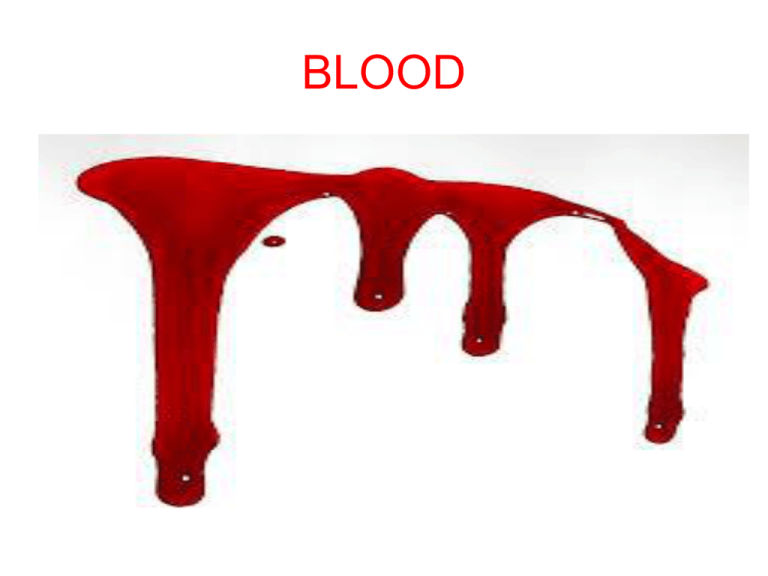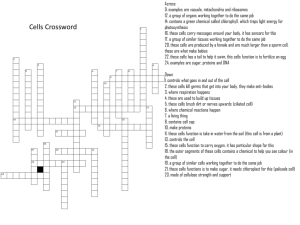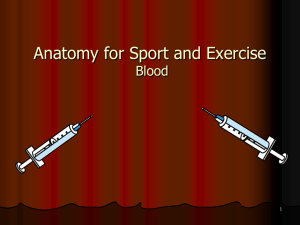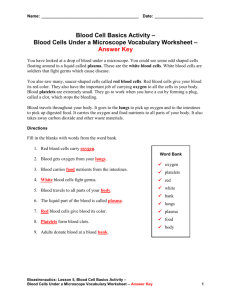Blood Biochemistry
advertisement

BLOOD Objectives At the end of this lecture student should be able to: 1. To know physical characteristics of blood. 2. Recognize functions of blood and its components. 3. To understand functions and Haemoglobin and Immunoglobin. 2 structure of BLOOD What is blood? Blood is a fluid connective tissue which contains red blood cells (RBC), white blood cells (WBC) and platelets. Blood is transported throughout the body by the circulatory system. Microscopic Views Fish Blood Bird Blood Horse Blood Frog Blood Cat Blood Dog Blood Human Blood Snake Blood Physical Characteristics of Blood • Thicker than water • 8 % of total body weight • Blood volume » 70 mL/kg of body weight » 5 - 6 liters in males » 4 - 5 liters in females • Temperature - 100.40F • pH - 7.35 to 7.45 Blood Functions 1. Respiratory Transport O2 from lungs to tissues Transport CO2 from tissues to lungs 2. Nutrition Transport “food” from gut to tissues 3. Excretory Transport waste from tissues to kidney (urea, uric acid) 4. Protective White blood cells , antibodies, antitoxins. Blood Functions 5. Regulatory regulate body temperature regulate pH through buffers coolant properties of water vasodilatation of surface vessels dump heat regulate water content of cells by interactions with dissolved ions and proteins 6. Body Temperature Water- high heat capacity, thermal conductivity, heat of vaporization Typical heat generation is 3000 kcal/day Blood composition Suspension of cells in plasma (carrier fluid) 45% Cells 55% Plasma Cells Red cells (erythrocytes) 5x106/mL White cells (leukocytes) 7x103/mL Platelets (thrombocytes) 3x105/mL 99% < 1% Blood composition Blood Plasma • Straw colored clear liquid • Contains 90% water • 7% plasma proteins created in liver confined to bloodstream albumin maintain blood osmotic pressure immunoglobulins antibodies bind to foreign substances called antigens form antigen-antibody complexes fibrinogen for clotting • 2% other substances Nutrients, electrolytes, gases, hormones, waste products Functions of plasma proteins 1. Coagulation of blood – Fibrinogen to fibrin 2. Defense mechanism of blood – Immunoglobulins 3. Transport mechanism – α Albumin, β globulin transport hormones, gases, enzymes, etc. 4. Maintenance of osmotic pressure in blood 5. Acid-base balance 6. Provides viscosity to blood 7. Provides suspension stability of RBC 8. Reserve proteins Formed Elements of Blood • Red blood cells (R.B.C.) • White blood cells (W.B.C.) granular leukocytes neutrophils: defence against invading micro-organisms. eosinophils: secrete lethal substances at the time of exposure to foreign proteins/parasites basophils: release some important substances like histamine, heparine. agranular leukocytes lymphocytes - T cells, B cells, natural killer cells (N.K.C) monocytes • Platelets (special cell fragments) Functions of RBC 1. Transport oxygen from lungs to the tissues (oxyhemoglobin). 2. Transport carbon-di-oxide from tissues to lungs (carboxyhemoglobin) 3. Hemoglobin acts as a buffer and regulates the hydrogen ion concentration (acid base balance) 4. Carry the blood group antigens and Rh factor Hemoglobin (Hb) is a hemoprotein only found in the cytoplasm of erythrocytes transports O2 and CO2 between lungs and various tissues normal concentration of Hb in the blood: adult males 135 – 175 g/L adult females 120 – 168 g/L Function of Haemoglobin When there is a high concentration of oxygen e.g in the alveoli haemoglobin combines with oxygen to form oxy-haemoglobin. When the blood reaches the tissue which have a low concentration of oxygen the haemoglobin dissociates with the oxygen and the oxygen is released into body tissues and carbon dioxide combines with the same haemoglobin which is finally expelled from the lungs. Structure of hemoglobin • Hb is a spherical molecule consisting of 4 peptide subunits (globins) = quartenary structure • Hb of adults (Hb A) is a tetramer consisting of 2 - and 2 β-globins → each globin contains 1 heme group with a central Fe2+ ion (ferrous ion) Immunoglobulins Structure and Function • Definition: Glycoprotein molecules that are produced by plasma cells in response to an immunogen and which function as antibodies. Amount of protein + albumin globulins 1 2 Immune serum Antigen adsorbed serum Mobility General Functions of Immunoglobulins • Ag binding – Can result in protection • Effector functions – Fixation of complement – Binding to various cells – Usually requires Ag binding Immunoglobulin Structure Disulfide bond • Heavy & Light Chains • Disulfide bonds – Inter-chain – Intra-chain Carbohydrate CL VL CH1 VH CH2 Hinge Region CH3 Thank you for your attention!





